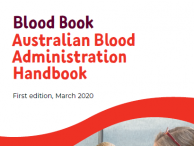Don’t have an account?
Select the donation type you’d like to make
Patient factors
Patients who have previously been transfused, multiparous women and patients receiving an emergency transfusion of uncrossmatched blood are at increased risk of immediate and delayed haemolytic transfusion reactions due to the presence of antibodies.
Allergic and anaphylactic reactions occur more commonly in patients with IgA deficiency and anti-IgA antibodies.
Febrile reactions occur more frequently patients who have received multiple transfusions and in multiparous women.
Transfusion-associated graft-versus-host disease (TAGVHD) is more likely to occur in certain immunocompromised patient groups or where donor and recipient have closely similar HLA types.
Transfusion-associated circulatory overload (TACO) is a particular risk in the very young, the elderly and in patients with cardiovascular disease.
Blood component factors
Platelet and granulocyte transfusions are associated with the highest rates of febrile non-haemolytic transfusion reactions (FNHTR). The incidence of such reactions can be reduced by modifying how blood components are processed and by leucodepletion. All red cell and platelet components produced by Lifeblood undergo pre-storage leucodepletion.
Platelets are stored at 20–24 ºC and are associated with higher rates of bacterial contamination than red cells. All platelets are subject to routine bacterial contamination screening (BCS), which allows the detection of bacterially contaminated products.
The transfusion of fresh frozen plasma is associated with a higher risk of allergic reactions. Some reactions are mild, but severe life-threatening reactions such as anaphylaxis and transfusion-related acute lung injury (TRALI) may occur.
Procedural factors
Clearly written procedures and appropriately trained staff are crucial for safe transfusions. This applies to all aspects of the transfusion process—from the initial collection of samples for pretransfusion testing through to the final documentation of the transfusion process and its outcome.
There are numerous opportunities for errors or omissions during the transfusion process if procedures are not strictly followed. Annual reports from the UK Serious Hazards of Transfusion (SHOT) program highlight that the majority of transfusion related adverse events are the result of 'wrong blood to wrong patient', with patient identification errors being the most common cause of preventable harm. Most errors result from a failure to follow procedures or from inadequate or unclear procedures.
Equipment factors
Blood components must be transfused using an approved administration set incorporating a 170–200 micron filter. The filter is required to remove clots and other debris.
Potential adverse effects caused by inappropriate equipment include heat damage to red cells due to an un-calibrated or poorly maintained blood warmer (i.e. red cells should not be warmed above 40 ºC); and mechanical damage to red cells through use of an inappropriate infusion pump.
Concomitant medications and intravenous fluids
No medications or solutions should be added to or infused through the same administration set as blood or components except 0.9% sodium chloride; for red cells, Albumin or ABO-compatible plasma are also permissible. .
Crystalloid and colloid solutions containing calcium (e.g. Haemaccel) must never be added to or administered through the same intravenous line as blood or components collected in an anticoagulant containing citrate, as they interfere with the anticoagulant effect, resulting in clotting.
Updated June 2025



